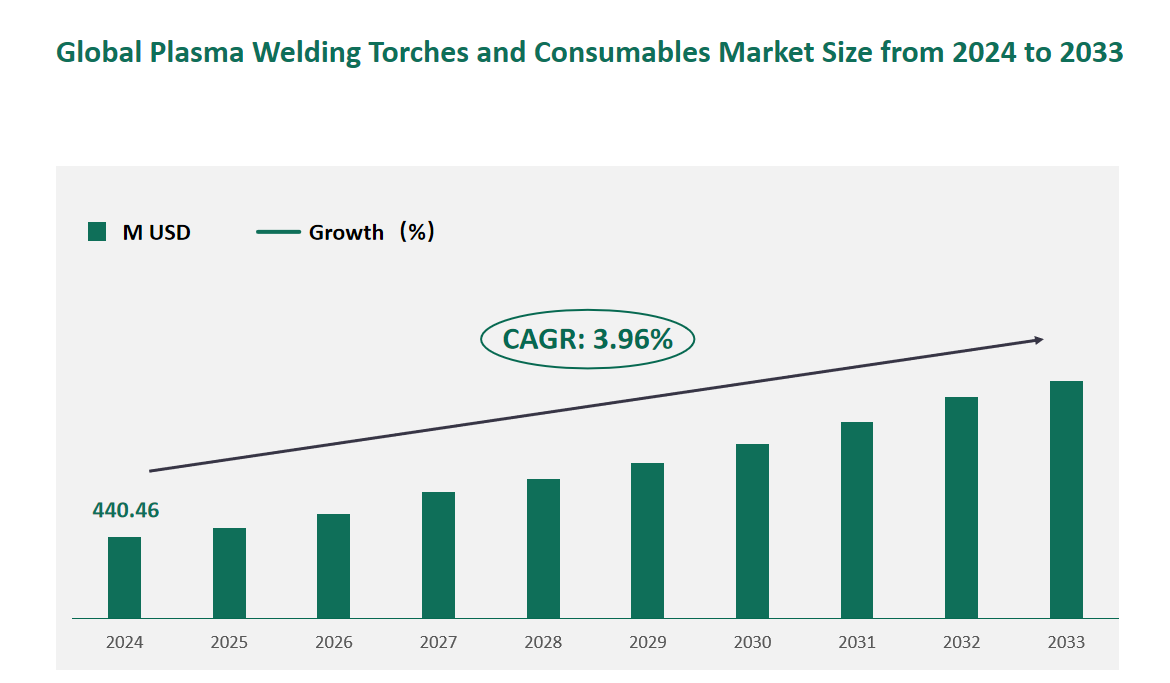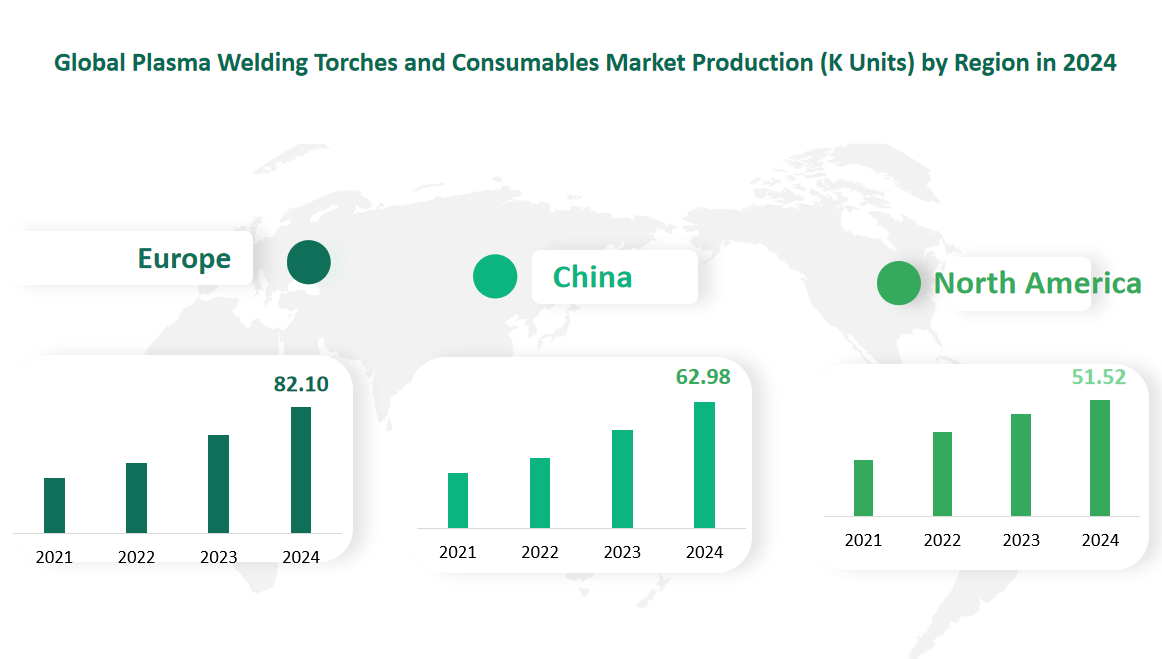1 Global Plasma Welding Torches and Consumables Market Size (Value) and CAGR (2024-2033)
In 2024, the global Plasma Welding Torches and Consumables market was valued at USD 440.46 million, with a CAGR of 3.96% from 2024 to 2033.
Plasma welding torches and consumables are integral components in the field of welding technology. Plasma welding torches utilize a plasma arc, which is a high-energy density beam, as the heat source for welding. This method offers several advantages, including energy concentration, high productivity, fast welding speed, minimal stress and deformation, and stable electrical isolation. These torches are particularly suitable for welding thin plates and box materials, as well as various refractory, easily oxidized, and heat-sensitive metal materials such as tungsten, molybdenum, copper, nickel, and titanium.
Figure Global Plasma Welding Torches and Consumables Market Size (M USD) and CAGR 2024-2033

2 Plasma Welding Torches and Consumables Market Growth Drivers and Industry Trends
The global market for Plasma Welding Torches and Consumables is experiencing significant growth, driven by a variety of factors that are shaping the industry’s trajectory. One of the primary drivers is the increasing demand for high-quality welding processes in various industrial sectors. The automotive, aerospace, and shipbuilding industries, in particular, rely heavily on plasma welding due to its ability to provide precise and high-quality welds. As these industries continue to expand and evolve, the need for advanced welding technologies like plasma welding is expected to grow.
Technological advancements are another key factor contributing to the market’s growth. Innovations in plasma welding equipment have led to improved efficiency, reduced downtime, and enhanced weld quality. For instance, the development of automated plasma welding systems has made the process more efficient and consistent, reducing the reliance on skilled labor and minimizing human error. Additionally, advancements in consumable materials have increased the durability and performance of welding torches, further enhancing their appeal in the market.
The global shift towards industrial automation is also playing a significant role in driving the demand for plasma welding torches and consumables. As manufacturers seek to improve productivity and reduce costs, they are increasingly adopting automated welding solutions. Plasma welding, with its high precision and speed, is an ideal choice for automated welding systems, making it a preferred technology for many industrial applications.
Environmental regulations are influencing the market as well. Stricter environmental standards are pushing manufacturers to adopt cleaner and more sustainable welding processes. Plasma welding offers several environmental benefits, such as reduced emissions and lower energy consumption, compared to traditional welding methods. This aligns with the growing emphasis on sustainability and eco-friendly practices in various industries, further boosting the market’s growth.
3 Plasma Welding Torches and Consumables Market Challenges and Restraints
One of the primary challenges is the high initial cost of plasma welding equipment. The sophisticated technology and specialized components required for plasma welding systems make them more expensive compared to traditional welding methods. This can be a barrier for small and medium-sized enterprises (SMEs) that may not have the financial resources to invest in such equipment, limiting the adoption of plasma welding in certain market segments.
Another significant challenge is the lack of skilled labor. Plasma welding is a complex process that requires highly skilled operators to achieve optimal results. The shortage of trained professionals in the industry can lead to difficulties in implementing plasma welding technologies effectively. This skill gap can result in lower productivity, increased downtime, and inconsistent weld quality, which may deter some companies from adopting plasma welding.
Competition from alternative welding technologies also poses a challenge to the market. Traditional welding methods, such as arc welding and gas welding, are well-established and widely used in various industries. These methods are often more cost-effective and require less specialized equipment, making them a preferred choice for many applications. As a result, plasma welding must continually demonstrate its advantages and cost-effectiveness to compete with these established technologies.
The economic volatility in various regions can impact the demand for plasma welding equipment. Fluctuations in industrial production, changes in government policies, and economic recessions can lead to reduced investments in capital-intensive technologies like plasma welding. During periods of economic uncertainty, companies may prioritize cost-cutting measures, which can result in decreased demand for plasma welding torches and consumables.
4 Global Plasma Welding Torches and Consumables Market Size and Share by Type in 2024
Plasma Welding Torches are the core tools used in plasma welding processes. They are designed to generate and control the plasma arc, which is the primary heat source for welding. These torches are available in various models, catering to different welding applications and requirements. In 2024, the revenue generated from Plasma Welding Torches is expected to be $137.01 million. This segment includes both manual and automated torches, with manual torches being widely used for their flexibility and ease of operation in various welding environments. Automated torches, on the other hand, are increasingly popular in industries that require high precision and repeatability, such as automotive and aerospace manufacturing.
Plasma Welding Consumables refer to the components that are used and replaced regularly during the welding process. These include electrodes, nozzles, swirl rings, and shielding caps. The revenue from Plasma Welding Consumables is projected to be $303.45 million in 2024. Consumables play a crucial role in maintaining the efficiency and quality of the welding process. For instance, electrodes are responsible for conducting the electrical current to the plasma arc, while nozzles help in shaping the arc and directing the shielding gas. The frequent replacement of these components ensures optimal performance and prevents issues such as arc instability and poor weld quality.
Table Global Plasma Welding Torches and Consumables Market Size and Share by Type in 2024
Type | Market Size (M USD) 2024 | Market Share 2024 |
Plasma Welding Torches | 137.01 | 31.11% |
Plasma Welding Consumables | 303.45 | 68.89% |
5 Global Plasma Welding Torches and Consumables Market Size and Share by Application in 2024
Manual Welding is a process where the welder directly controls the welding torch and the movement of the electrode. This application requires a high level of skill and precision, making it suitable for complex and intricate welding tasks. In 2024, the revenue from Manual Welding is expected to reach $93.52 million. This segment is widely used in industries such as shipbuilding, where welders need to navigate complex geometries and tight spaces. Additionally, manual welding is prevalent in the construction sector for tasks like structural steel welding, where flexibility and adaptability are crucial.
Automatic Welding involves the use of automated systems and robots to control the welding process. This application is highly efficient and consistent, making it ideal for mass production environments. In 2024, the revenue from Automatic Welding is projected to be $346.94 million. The automotive industry is a major consumer of automatic welding, as it requires high-speed and precise welding for assembling vehicle components. Similarly, the aerospace industry benefits from automatic welding for its ability to produce consistent and high-quality welds in critical components, ensuring safety and reliability.
Table Global Plasma Welding Torches and Consumables Market Size and Share by Application in 2024
Application | Market Size (M USD) 2024 | Market Share 2024 |
Manual Welding | 93.52 | 21.23% |
Automatic Welding | 346.94 | 78.77% |
6 Global Plasma Welding Torches and Consumables Market Production (K Units) by Region in 2024
North America is a key market for plasma welding, with a production of 51.52 thousand units in 2024. The United States, in particular, is a major driver of this market, due to its robust manufacturing sector and advanced industrial infrastructure. The automotive and aerospace industries in the region are significant consumers of plasma welding equipment, as they require high-quality and precise welding solutions for their operations. Additionally, the presence of leading manufacturers and research institutions in North America has fostered innovation and technological advancements in plasma welding technologies.
Europe is another prominent region in the market, with a production of 82.10 thousand units in 2024. Countries like Germany, France, and the United Kingdom have well-established manufacturing industries that rely heavily on plasma welding. The region’s focus on precision engineering and high-quality manufacturing has made it a hub for advanced welding technologies. The automotive, aerospace, and shipbuilding industries in Europe are major consumers of plasma welding equipment, driving the demand for both torches and consumables.
China is experiencing rapid growth in the plasma welding market, with a production of 62.98 thousand units in 2024. The construction, automotive, and electronics industries in China are major contributors to the demand for plasma welding equipment. The region’s growing economy and infrastructure development are also fueling the adoption of advanced welding solutions, as companies seek to improve productivity and quality in their operations.
Figure Global Plasma Welding Torches and Consumables Market Production (K Units) by Region in 2024

7 Major Players in Global Plasma Welding Torches and Consumables Market
7.1 Abicor Binzel
Abicor Binzel is a renowned manufacturer of welding and cutting equipment, with a history dating back to 1945. The company is headquartered in Germany and has a significant presence in the Asia Pacific region.
Abicor Binzel offers a wide range of products, including plasma welding torches and consumables, designed for both manual and automated welding applications. Their products are known for their reliability, precision, and durability, making them suitable for various industries such as automotive, aerospace, and shipbuilding.
In the recent year, Abicor Binzel reported a revenue of $30.53 million and a gross margin of 31.13%.
7.2 EWM
EWM is a leading player in the plasma welding market, established in 1957. The company is based in Germany and has expanded its operations to include manufacturing facilities in China. EWM is committed to developing innovative welding technologies that enhance the efficiency and sustainability of the welding process. Their product portfolio includes water-cooled plasma welding torches, which are designed for optimal performance and minimal gas consumption. These torches are widely used in industrial applications due to their compact design and high performance.
Over the past year, EWM achieved a revenue of $12.51 million and maintained a gross margin of 28.90%.
7.3 Parweld
Parweld is a global player in the design and manufacturing of welding products, with its establishment in 1972. The company has manufacturing facilities in China and the UK, allowing it to serve customers worldwide. Parweld offers a comprehensive range of plasma welding torches and consumables, known for their ergonomic design and high performance. Their products are designed to provide users with comfort and precision, making them suitable for various welding applications.
In the recent year, Parweld reported a revenue of $7.03 million and a gross margin of 29.53%.

